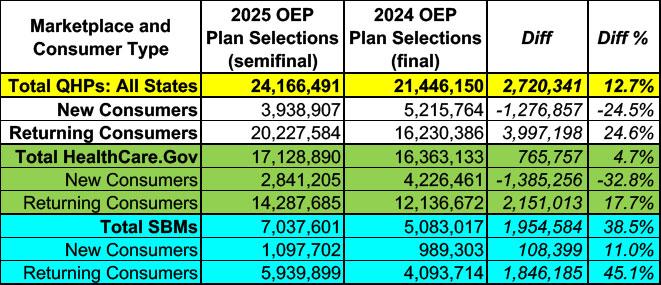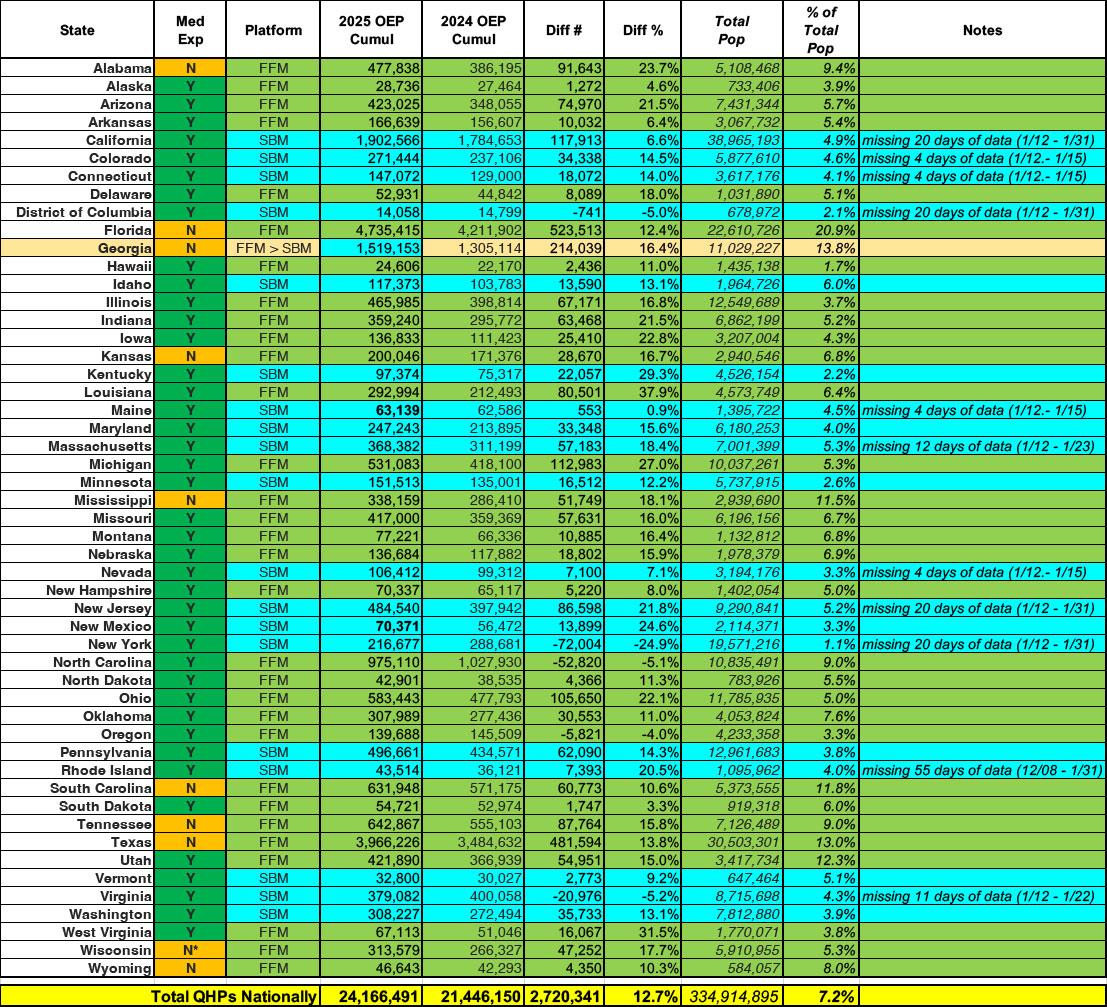BOOM: ACA Open Enrollment hits nearly 24.2M QHPs, nearly 26M w/BHPs included!

A week or so ago the Centers for Medicare & Medicaid Services (CMS) issued a semi-final 2025 ACA Open Enrollment Period report, which noted that 23.6 million Americans had selected 2025 plan year coverage via the various ACA marketplaces since November 1st...as of either January 4th or December 28th, depending on the state.
Those thru dates are important, of course, because the 2025 OEP was still ongoing in every state except Idaho at the time...and in fact it's still going on in several of them, including CA, DC, MA, NJ, NY, RI & VA. In some of these states the final deadline is still up to 2 weeks away.
Last year, after OEP ended for most states on Jan. 15th, CMS issued a follow-up enrollment report on Jan. 24th, 2024. Given that the Trump Administration is about to take over the entire federal government (including the HHS Dept.) this coming Monday, I expected the Biden Administration to post a final ACA Open Enrollment Report before then...and sure enough, that's exactly what they did today:
Over 24 Million Consumers Selected Affordable Health Coverage in ACA Marketplace for 2025
The Centers for Medicare & Medicaid Services (CMS) is committed to a robust Marketplace Open Enrollment process for consumers so they can effortlessly purchase quality, affordable health care coverage. CMS reports that 24.2 million consumers selected plan year 2025 coverage through the Marketplaces during the 2025 Marketplace Open Enrollment Period, including 3.9 million new consumers. That represents more than double the number of enrollees compared to the 2021 Open Enrollment Period.
“The number of people signing up for Marketplace coverage has surpassed 24 million, an all-time high, breaking last year’s record. I’m proud of the work done by the Biden-Harris Administration and the U.S Department of Health and Human Services over the past four years to help more people access quality, affordable health care and bring down the uninsured rate,” said Health and Human Services (HHS) Secretary Xavier Becerra.
“Since the law was enacted, 50 million people — or one in seven Americans — have signed up for coverage through the Marketplace. Now, Congress must do its job so those millions of Americans remain covered. The tax credit that has helped people purchase coverage will expire at the end of 2025 unless Congress makes it permanent or extends it. Congressional inaction would result in costs going up. More than five million people could lose their coverage entirely, and millions of other hard-working Americans could face premium increases of more than 50%. The Affordable Care Act belongs to the American people. Let’s keep it that way.”
“The record-breaking success of this year’s Marketplace Open Enrollment speaks volumes about the Affordable Care Act’s past, present, and future serving the American people by connecting our communities to high-quality, person-centered, affordable health care coverage. That priority can and should continue to generate broad, bipartisan support, as it has under the Biden-Harris Administration,” said CMS Administrator Chiquita Brooks-LaSure.
CMS Administrator Brooks-LaSure added: “This record-breaking enrollment is also a testament to the importance of the enhanced financial assistance available through 2025. This additional help has made all the difference for people seeking affordable insurance. For example, a young professional just starting out making $30,000 a year would have previously been expected to contribute around $165 per month but can now pay no more than $50 per month, with even cheaper plans available. Just a little extra help can mean less financial stress for millions of enrollees across the country.”
Thanks to the Biden-Harris Administration, consumers had greater plan choices for 2025, as well as other important supports. The Inflation Reduction Act of 2022, for example, means many middle-income people and families who were previously ineligible for financial assistance have access to lower premiums after tax credits, and many modest-income Americans now have more help paying for premiums. Because of the enhanced and expanded tax credits, four out of five HealthCare.gov consumers could find a plan for $10 or less per month. The enhanced tax credits remain available through 2025 but are set to expire in 2026 without Congressional action.
Marketplace Open Enrollment on HealthCare.gov ran through January 15. Consumers who enrolled by midnight local time on January 15 got coverage that will start February 1, 2025. State-based Marketplace enrollment deadlines vary. State-specific deadlines and other information are available in the State-based Marketplace Open Enrollment Fact Sheet.
Here's the top line numbers, including the final OEP data from last year. It's important to note that while the data runs through the same date in 31 states (Jan. 15th for HC.gov states except Georgia; Dec. 15th for Idaho), there's still enrollment data missing for 19 of the state-based exchanges, which I'll specify below:
Boom: With up to 2 weeks left for people to enroll in several states, total enrollment is more than 12.7% higher year over year nationally. New enrollments are down nearly 25%...but returning enrollees are up by nearly 25%, far more than cancelling that out.
It's also important to note that the seemingly massive gap between the HC.gov and SBM changes aren't nearly as dramatic as they appear--remember, Georgia moved from the former to the latter this year. When you account for that, it looks like this (CMS hasn't provided the state-level new vs. renewal breakout yet):
In other words, when you adjust for Georgia's move, there's not much difference between the FFM (up 13.8%) and SBMs (up 10.2%) states this year, especially considering that there's still data missing for many of the SBM states.
When we break it out by state, it gets even more impressive:
Noteworthy data points:
- FLORIDA continues to blow away every other state in raw enrollees, with over 4.7 MILLION residents having signed up so far...nearly 21% of their entire population, up over 520,000 vs. last year.
- Other major raw enrollment increases are being seen in Texas (+481K), Georgia (+214K) and California (+117K), with Michigan and Ohio also boosting their enrollments by over 100K apiece.
- The only states to see a net decrease in Qualified Health Plan (QHP) enrollments are New York, North Carolina, Virginia, Oregon and DC.
However, North Carolina's drop is due to them expanding Medicaid a year ago (which siphoned off a chunk of their low-income exchange enrollees), while New York similarly expanded their Basic Health Plan (BHP) program last spring and Oregon launched theirs last summer, both of which, again, cannibalize a portion of residents who would otherwise be enrolled in exchange plans. DC's reduction, meanwhile, is nominal. The only state I'm scratching my head over is Virginia, which saw a 5.2% drop in enrollment without anything obvious happening to account for it.
- On a percentage change basis, LOUISIANA is leading the way with a 38% increase year over year, followed by West Virginia (+32%), Kentucky (+29%), Michigan (+27%) and New Mexico (+25%).
- Again, setting NY, NC & OR aside, only VA & DC are down vs. last year.
Again, there's still up to two weeks left for people to enroll in several states.
UPDATE 1/24/25: A few more states (CO, CT, ME & NV) have chimed in with their final official OEP tally, bringing the grand total up to 24,183,441 QHPs + 1,754,822 BHPs for a combined total of 25,938,263.
My guess is that the remaining states will add something like:
- CA: 20,000
- DC: 120
- MA: 3,400
- NJ: 20,000
- NY: 5,300
- RI: ???
- VA: 4,800
...or perhaps another 30,000 or so total QHPs nationally when the dust settles, give or take.
But wait, there's more! Speaking of the Basic Health Plan (BHP) programs in New York, Minnesota and Oregon, from the footnote in CMS's press release:
As of January 11, 2025, Oregon had 32,239 individuals enroll in a BHP, and New York had 1,641,960 individuals enroll in the EP Expansion under the state’s approved section 1332 waiver program. Minnesota’s BHP data was not available at the time of this report.
I don't know why CMS always says that about Minnesota, however, since they do have monthly Minnesotacare enrollment reports available, including for January (80,623).
Combined, that's 1,754,822 BHP enrollments across all three states, which is up about 14% vs. BHPs last year.
Adding those to the QHPs brings the grand total up to 25,921,313 QHPs + BHPs combined, which again will likely come extremely close to breaking 26.0 million when the dust settles.
Finally, I already noted that there doesn't seem to be much of a gap between federal and state-based exchanges this year in terms of enrollment growth, but it's also worth noting that similarly, there's very little difference between expansion and non-expansion states this year: Expansion states wend up 11.1% vs. 14.1% in non-expansion states, and when you further parse out HC.gov states between expansion/non-expanson there's even less difference.







